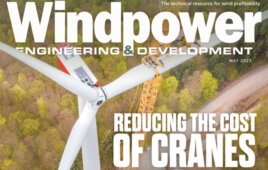Wind worth harvesting
A big sign propped up at the entrance of my local farmers’ market read: If you ate today, thank a farmer. My dad grew up on a farm in the Canadian prairies, so this is wise advice to me. He’s shared plenty of stories about farming life, and the hard work and dedication that goes into it. He loved harvesting crops with my grandfather but there were years their efforts yielded little reward.
However, if my granddad had the option to own or lease a wind turbine on his property, the years of low crop production may have been less troublesome for the family (my grandparents had five kids to feed). Wind energy offers farmers a unique opportunity to save on electricity costs and earn additional revenue. In fact, it is now possible for many farmers to lease a wind turbine for zero money down while benefiting from its production of lowcost renewable energy (see page 10 of this issue).
What’s more is research shows that wind turbines may have a positive effect on crops. A multiyear study, led by Iowa State University, examined the effects of turbulence (produced by moving turbine blades) and found a measurable impact on several key variables that affect the growing conditions for crops. For example, the researchers found that changes in air pressure from turbineinduced turbulence may enrich the carbon dioxide content in the air surrounding crops — which could, in turn, help crops grow more efficiently. In addition, the turbulence suppresses the formation of dew and dries the crops, which may combat harmful molds and fungi.
Currently, American farmers are facing extremely low agricultural commodity prices despite rising production costs. According to a recent blog post from the American Wind Energy Association (AWEA), the total value of the U.S. corn, soybean, and wheat crops dropped 10% or roughly $13 billion in June of this year alone. Soybean prices have fallen around 18%, heading to their lowest point in nearly a decade. As AWEA points out, “volatile commodity prices affect a farmer’s bottom line, putting them at risk for significant debt or even bankruptcy.”
Unlike my dad and granddad, however, many of today’s farmers can choose wind power to secure a source of dependable revenue. These statistics from the American Farm Bureau Federation provide a snapshot of why farm work is essential to the economy and our communities.
- One farm feeds 165 people annually in the United States and abroad
- About 99% of American farms are operated by families
- Agriculture is the largest employer in the United States, providing jobs to 23 million Americans
- Farmers and ranchers receive only 15 cents out of every dollar spent on food at and away from home. (The rest goes to wages and materials for production). In 1980, farmers and ranchers received 31 cents.
- There are over two million farms in America
- Women make up 30% of the total number of U.S. farm operators
 Last year, farmers were paid an estimated $267 million to lease land for wind development. With support from local communities, government, and the wind industry let’s ensure farmers receive the support they need to succeed. After all, I’ve heard life is better on a farm.
Last year, farmers were paid an estimated $267 million to lease land for wind development. With support from local communities, government, and the wind industry let’s ensure farmers receive the support they need to succeed. After all, I’ve heard life is better on a farm.
To the ranchers and farmers who work hard every day, and to those who make my weekend farmers’ market visits possible, a special thank you.
Michelle Froese
Senior Editor
Windpower Engineering & Development
Filed Under: Digital issues




